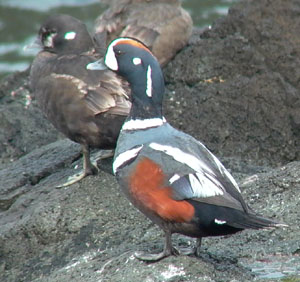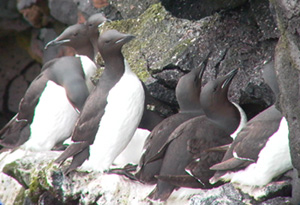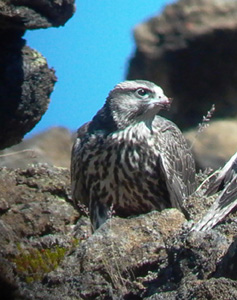Photos with this report (click to enlarge) | |||
 Harlequin Duck |
 Brunnich's Guillemot |
 Gyrfalcon |
|
This trip report details a recent 8-day trip to Iceland, which included a search for some of the Icelandic specialities along with a whale-watching trip from the northern port of Husavik. As would be expected the trip list wasn’t exactly huge at 73 species, however the quality of the birding was excellent with many species much more approachable here than elsewhere in their breeding ranges. The highlights were Gyrfalcon, Harlequin Duck, Brunnich’s Guillemot, Arctic Foxes and Humpback Whales. If you would like any further information that isn’t included in the report please contact me, peterstronach@gmail.com.
The itinerary started and finished at Keflavik near Reykjavik and included a complete circuit of the island, you could easily spend two weeks doing this if not more:
6th July 2007: Flight from London Heathrow to Keflavik Airport, overnight camping at the campsite at Garodskagi lighthouse at the end of the peninsula next to Gardur, west of Reykjavik.
7th July 2007: Birding Gardur, Sandgerdi, then a drive to Pingvellir, then onto Snaesfellness Peninsula via Kaldidalar valley, birding Rif lagoons then overnight camp next to the lighthouse at the Ondverdanes peninsula, Snaesfellnes.
8th July 2007: Drive to Stykkisholmur, ferry across Breidafjordur to Flatey Island, overnight stay and birding on Flatey.
9th July 2007: Ferry across Breidafjordur to Brjanslaekur, drive to Bjargtangar and the Latrabjarg cliffs, overnight stay at Grettislaug, north of Saudarkrokur.
10th July 2007: Drive to and birding Lake Myvatn area, overnight camping at Rejkjahlio.
11th July 2007: Early morning birding Lake Myvatn area then a drive to Husavik and a whale-watching trip, overnight camping and birding at Hraunhafnartangi, north of Raufarhofn.
12th July 2007: Drive to and overnight camp at Svinafell, Skaftafell via birding at Borgafjordur Eystri and Jokulsarlon.
13th July 2007: Drive to Rejkjavik via Geyser, overnight stay at the campsite at Garodskagi lighthouse at the end of the peninsula next to Gardur, west of Reykjavik.
14th July 2007: Flight from Keflavik to London Heathrow.
Useful Sources of Information:
The following were very useful before and during the trip:
· The Icelandic Birding Pages, http://www.hi.is/~yannk/birdnews.html
· Euromap: Iceland 1:750000
· (2007) Rough Guide to Iceland
Key Sites
Gardur and Garodskagi
Garodskagi is an excellent place to camp if you arrive late into Keflavik and need somewhere near the airport to stay on the first night, be prepared for constant calls of seabirds all night though and if you struggle to tune-out Oystercatcher calls this may not be the place for you!. At sea there were plenty of Manx Shearwaters passing the point next to the lighthouse in the strong westerly wind. Several searches of the nearby Gardur lagoons revealed no sign of the resident Black Duck. Large gull flocks at Sandgerdi and the at the Gardur lagoons contained plenty of Glaucous Gulls, along with hybrid Herring Gull x Glaucous Gulls. There is also a huge Arctic Tern colony nearby in a protected area for Eiders just down the road at Hvalsnes where hundreds of terns sit on the tarmac road as you drive through.
Ondverdanes
This peninsula at the western end of Snaesfellnes is accessed on a gravelled road from Hellisandur that passes through a beautifully bleak and sparsely vegetated lavafield, the accessible seabird cliffs are at the lighthouse, not at the area signposted Ondverdanes which is nearby. There are huge vibrant seabird colonies here and it is possible to get very close to and get cliff top views of the many breeding Brunnich’s Guillemots present. We were woken during the night by two Arctic Foxes, in their summer coats, as they called to each other walking through the lavafield close to the lighthouse and passing close to the tent.
Rif lagoons
There are several large brackish lagoons on the landward side of the main 54 road as it passes south of the village, these contained several hundred feeding and preening Red-necked Phalaropes and 1 Grey Phalarope in summer plumage as well as large numbers of Dunlin. There were some huge gull gatherings along the coast and further inland to the east of this area, also along the coast to the east were many Harlequin Ducks on the sea.
Flatey Island
This peaceful island in the Breidafjordur is accessed by ferry from Stykkisholmur or Bryjanslaekur, we travelled from Stykkisholmur, left the car on the ferry to be collected the following morning and stayed the night on the island. Our small chalet “Linukot” was excellent and a welcome break from the tent, we also had the bonus of breeding Redwing and Snow Bunting in the garden, which were singing all night!. The eastern end of the island is a nature reserve which unfortunately was out of bounds between mid-May and mid-July, we did however walk along the boundary while getting severely mobbed by the large Arctic Tern colony. The density of breeding waders on the island is fantastic, Snipe, Redshank and Oystercatchers on every fencepost and Red-necked Phalaropes in the ditches and running along the paths a few yards in front of you!. We unfortunately did not see any Grey Phalarope here but saw many passage waders on the mud in the numerous coastal bays.
Bjargtangar, Latrabjarg
The immense sea-cliffs at this remote point are an awesome spectacle, there is literally thousands and thousands of seabirds passing the point and you quickly become disorientated trying to seawatch!. There were several Arctic Skuas here patrolling the cliffs pirating the returning Puffins, Guillemots, Razorbills and Brunnich’s Guillemots.
Lake Myvatn
This area is what you might call a duckfest! We started at the bridge over the River Laxa at the western end of the lake, which is just a stunning location, there were several female ducks braving the rapids with ducklings in tow, including Harlequin Duck and Scaup. We then stopped at Alftavogur bay and scoped the lake, the number of ducks and ducklings was incredible, on the landward side of the layby a very small waterbody held a Slavonian Grebe and family. Further around the southern end of the lake on the Kalfastrond peninsula there was a small cove, which had a flock of around a hundred Barrow’s Goldeneye roosting and preening. In the afternoon we explored the area to east of the lake on the road to Krafla, the highlight was a pair of breeding Merlin. Later in the evening I walked to Vindbelgarfjall from the adjacent main road, on my return driving from the carpark up the gravel slope to the main road the road gave way, leaving the hire car sat on the front two wheels, at an angle of 45 degrees and the boot sticking up in the air!. Luckily I managed to find a local farmer who towed the car out. Speaking to him afterwards, he mentioned that he had nestboxes in his barn containing incubating Barrow’s Goldeneye and he let me climb a ladder to view them. He was expecting them to hatch anyday, the female was sitting on 12 eggs weighing in total 800g which must be very close to the weight of the female that laid them over the course of two weeks!.
Later in the evening I checked an area close to the lake and found a family of Gyrfalcons, 2 adults one almost pure white and four fledged young. The following morning I checked the area again and was lucky enough to see the two adult birds leave on a hunt returning ten minutes later with a redwing which was quickly decapitated and given to the young.
Husavik and Skjalfandi bay
A three hour whale-watching trip from this port produced sightings of Harbour Porpoise, White-beaked Dolphins, Minke Whale and three Humpback Whales. The captain managed to get close enough to the Minkes so that we could smell their rancid breath I’m not sure whether that was appreciated by all on board. The Humpbacks weren’t being quite as co-operative but blew on several occasions and deep dived several times showing flukes.
Borgafjordur Eystri
There was no sign of the long staying drake Steller’s Eider at this site when we checked but plenty of Harlequin Duck’s sheltering from the surf in the bay from the birdwatching hide.
Jokulsarlon
We stopped at this glacial lake which has calfed lumps of glacier floating in it, there was a great spectacle of hundreds of Arctic Terns fishing in the outfall to the sea being pursued by around 40 Arctic Skuas. This area also had high densities of Bonxies/ Great Skua, and many were seen next to the roadside.
The following list details specific sites for several of the specialities.
Brunnich’s Guillemot: large numbers present in the seabird colonies at Ondverdanes peninsula, Snaesfellnes and Latrabjarg, Vestfirder.
Grey Phalarope: 1 summer plumaged bird in a large flock of Red-necked Phalaropes at the Rif lagoons.
Harlequin Duck: Females with young on the River Laxa adjacent to the bridge at the western end of Lake Myvatn. Many birds on the northern coast of the Snaesfellnes peninsula and in the bay at Borgafjordur Eystri.
Barrows Goldeneye: All in the Lake Myvatn area, several on the River Laxa adjacent to the roadbridge to the west of the lake, a flock of nearly a hundred in a small cove at the Kalfastrond peninsula.
Gyrfalcon: A family of 2 adults and four young in the Lake Myvatn area.